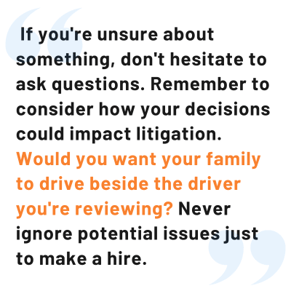Welcome to our latest blog interview, where we delve into the world of driver recruiting and compliance with Robin Aldredge, Senior Customer Success Strategist and compliance pro at DriverReach. Read on to learn more about her experience leading compliance teams and her tried-and-true tips on processing and managing driver qualification files.
 Can you tell us a bit about your experience in the driver recruiting and compliance world? What's your journey been like in this industry?
Can you tell us a bit about your experience in the driver recruiting and compliance world? What's your journey been like in this industry?
I started DOT’ing files back in 2015, which is when I quickly discovered my knack for ensuring DOT compliance. I spent almost eight years handling compliance tasks at various large carriers. From processing and VOEs to scheduling randoms and physicals, I love tracking all the details!
I quickly realized how exciting investigating drivers could be, but I did not start teaching myself the regulations until 2019. I was tasked with creating a Standard Operating Procedure (SOP) for the Recruiting Department where I worked. I learned how defining a good process flow and identifying dams greatly impact approval time, time to hire, and cost per hire. My love for the regulations and for a good SOP bloomed as I experienced firsthand how a well-documented, up-to-date manual impacts your team’s success.
Since then, I have continued to create SOPs for my teams and have continued to expand my knowledge of the regulations. I recently completed the NATMI Safety Supervisor course and am actively working on obtaining my certification.
Understanding the FMCSA's DQ Checklist:
How do you review driver qualification files accurately, and what's the role of a checklist in the process?
It is crucial to create a well-defined process when handling DQ files. Deviations could lead to issues like missing details and overlooking disqualifying information.
For me, a checklist is the first step in defining your process and confirming you are meeting the minimum requirements for the industry. (Of course, carriers can do more, but they can’t do less.) Without a checklist, when completing a review of an application, you will end up missing something. This is even true for people who’ve been DOTing files for years.
Think of it like this: how easy is it to forget what you need from the grocery store when you leave your grocery list at home? That confirmation when you’re heading to the checkout line, scanning to ensure you haven’t forgotten any items, is comparable to the DQ checklist.
It’s that nice reminder and confirmation of what you need for a DQ file. And if you’re doing ✅❌, that quick glance may be all you need to know you’ve completed the necessary steps per item.
As a reminder, the checklist being complete does not equal compliance.
Essential Documents for DQ Checklist Compliance:
Regarding the DQ checklist, what’s common to miss or overlook?
It can be confusing to understand what to do with the information you receive, whether verbally from a driver, in writing on an app, or returned on a background check. A common mistake is not to ask someone what you’re supposed to do with that information. Assuming “everything will be okay” can lead to a big deal for a carrier.
As an example, when reviewing an MVR, you must pay attention to the spelling of the applicant’s name, the address, the class, status, expiration date, endorsements, restrictions, med card info, violations, accidents, suspensions, pending items, info for SAP programs, and additional licenses listed. But when you see this info, what do you do with it? And who do you ask if you don’t really know? All variances and discrepancies should be investigated and documented.
Best Practices for Document Organization and Maintenance:
How do you suggest compliance teams keep all these documents in order and easily accessible? Do you have any tips on making this process efficient and organized?
From what I've seen, digital is the way to go. Paper files are a hassle, they take up too much space and it's easy to lose them or mix them up. I would not have been so organized and successful in my career without an ATS.
Unfortunately, I wasn’t lucky enough to utilize DriverReach in my former life (Seriously, we make it so easy! ). Our platform is so user-friendly it doesn’t take months to figure out. The layout makes sense, and I love our Saved Views to track and organize information per person/job/responsibility. You don’t have to sift through so many files like I was used to.
I’m constantly amazed at what the DriverReach platform does, especially when I discover we do something I had wanted for so long in the ATS I previously used.
But even if you’re reading this and don’t have an ATS (yet!) The best advice is to look at the entire process— the more defined, the better. Break down dams, tweak your process, score, and then tweak again until your process is equivalent to a well-oiled machine. When this is accomplished, you can really decrease/impact your time to hire and cost per hire. It’s really cool to see the cost per hire per recruiter!
By examining and rebuilding the entire process flow, my former team had an approval time of 4 hours, and we could get a driver in a truck and rolling in just three days. Talk about exciting!
Navigating Challenges and Changes
What are some common challenges compliance teams face, and how can they stay on top of the game amidst regulation changes?
Technology changes so fast, along with regulations, and it can get confusing sometimes. There are also specific carrier requirements that can be hard to understand. The problem is that some carriers don't communicate these changes well or provide enough training. To make sure you stay up to date, it's a good idea to subscribe to newsletters, attend webinars, and learn how to navigate these regulations yourself. And if you need extra help, I can’t say enough about the new Driver Qualification Checklist and how it teaches users and keeps them on track for completing DQ files. It is a great resource and tool for new and seasoned compliance professionals like myself. #itsnotjustachecklist 😉
 Technological Solutions and Innovations
Technological Solutions and Innovations
What tips and tricks would you recommend to make the compliance process smoother for teams?
Again, I really recommend developing an SOP for your team or company. Having a step-by-step guide that everyone can refer to is so beneficial, especially to new team members. If you don’t have one in place already, start by involving all the people who are important to your compliance process and make sure you document every step—including backup plans for any problems that might come up. Once you have your SOP, stick to it and make sure everyone knows about it and where to find it.
It's important to remember that there is not always a one-size-fits-all answer for every situation you encounter. I found it helpful to keep my SOP as a live document so that folks in my organization could keep up with the changes in real-time. Part of making an airtight SOP is transparency and frequent communication with your teams — it will do wonders in getting everyone on the same page.
Training and Education for Compliance Teams
Staying in the know is key. What are some fun and effective ways compliance professionals can keep learning and growing in their roles?
Keeping up with the latest information is super important for compliance folks, and I’m thankful there are so many great, current, and engaging resources available on the internet. LinkedIn is a great place to start. Follow the big names and associations in the industry and sign up for free webinars. Our friends over at Trucksafe Consulting are a wonderful resource and a lot of folks at DriverReach share great content to help you stay on top of trends.
And if you’re like me and love geeking out on regulations—or even if compliance isn’t your thing and you want to get better at it—connect with me, and let’s chat!
Achieving Proactive Compliance
Nobody likes putting out fires. How can compliance teams be proactive and avoid compliance issues in the first place?
When you are working on files, it is important to take your time and avoid rushing. If you get sidetracked or interrupted, it's best to start over instead of trying to remember where you left off. It can be confusing and lead to errors if you try to resume "DOTing" a file after stepping away to work on other tasks. If you're unfamiliar with the term "DOTing a file"—definitely reach out to me!
Final Tips and Words of Advice
If you had to share a golden nugget of advice with our readers, what would it be for compliance teams hustling in the motor carrier industry?
Slow down again :) We tend to rush in this industry, which can lead to mistakes and details being missed. It's important to have a solid process and do the same thing every time you work on a file or review a document. When working on files, I follow a consistent process. I start at the same place every time, review applications in the same way, and review documents in the same order every time. If you're unsure about something, don't hesitate to ask questions. Remember to consider how your decisions could impact litigation. Would you want your family to drive beside the driver you're reviewing? Never ignore potential issues just to make a hire.






